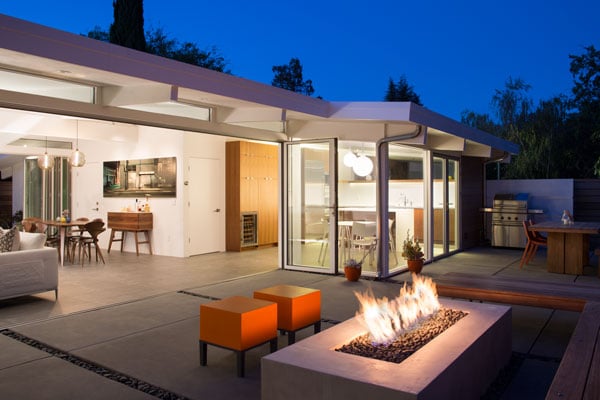How do you improve on a classic or update something that was vastly ahead of its time 60 years ago? Ask Klopf Architecture. The San Francisco firm specializes in designing remodels and additions to classic Eichler homes like this one in Palo Alto—one of the thousands of mid-century modern residences built by developer Joseph Eichler in California in the 1950s and ‘60s. Known for their inside/outside relationship and minimal detailing, Eichlers embody a style that is “clean and modular, understandable, and at rest,” says principal John Klopf.
Clients who live in these homes are living in a piece of history. But as well designed as these residences might be, they can feel somewhat outdated for the modern family. “People today are looking for ‘flowy’ spaces where everyone can hang out together in a great room or around the kitchen as the heart of the home,” Klopf says. The goal for this Palo Alto home was to maintain its modern look and feel while creating a deeper connection with the outside and making the spaces more suitable for entertaining.
Expanding on the original walls of glass and connection to nature so common in Eichler homes, Klopf designed a remodel that relocated the kitchen away from the entry, removed a heavy brick fireplace, and opened up the great room completely to the outdoors with folding glass walls to improve the flow. “Opening up the two walls of the great room turned the house conceptually into an open-air pavilion with two cedar-clad ‘blocks’ of house on either side,” Klopf says. The open-air pavilion extends side to side on the property, incorporating both side yards into the great room. This space, which contains the living and dining areas, is the heart of the home, and when opened up makes the relatively small house seem large, with outdoor living areas that include a fountain, fire pit, and dining area. Taking the concept of borrowed landscape from traditional Japanese architecture, the fountain, concrete bench wall, and natural landscaping bound the indoor/outdoor space. Plus, the roof extends past the folding glass door walls to help blend the interior and exterior spaces and provide shade and additional protection from the rain.
PROJECT
Location Palo Alto, CA
Size 1,662 ft² plus garage
Completion 2014
TEAM
Architect Klopf Architecture
Landscape Architect Arterra Landscape Architects
Structural Engineer Brian Dotson Consulting Engineers
Contractor Flegel’s Construction
The color and materials palettes also promote openness. Cedar siding covers the two wooden boxes of the house, except for the white walls that continue along from exterior to interior to exterior in the great room. The smooth white surface extending from outdoors to indoors to outdoors again further blends the interior and exterior spaces and also provides a conceptual cut through the house, reinforcing the void that separates the two wooden boxes. Gray porcelain tile floors turn into gray concrete at the side yards and front walkway and driveway. “Continuing the white walls and gray floors from inside to out really emphasizes the indoor/outdoor living style as well,” Klopf says.
Even the bathrooms are open to nature. The master bath acts like a tunnel to the outside, with a full glass wall in the shower that looks onto the private, landscaped rear yard, giving homeowners the feeling that they are showering outside.
 All of this openness presented some structural challenges though. The biggest technical obstacle, according to Klopf, was incorporating enough structural strength at the two folding walls to allow the whole walls to open up completely, while keeping the Eichler aesthetic intact—structurally minimal, elegant, and simple. “We ended up putting steel moment frames in that went over the roof to keep the lightness of the construction and openness of the walls,” he says.
All of this openness presented some structural challenges though. The biggest technical obstacle, according to Klopf, was incorporating enough structural strength at the two folding walls to allow the whole walls to open up completely, while keeping the Eichler aesthetic intact—structurally minimal, elegant, and simple. “We ended up putting steel moment frames in that went over the roof to keep the lightness of the construction and openness of the walls,” he says.
With its ultra open spaces, the house requires no air conditioning. A new radiant in-floor heating system was installed, along with a super-insulated roof, all new double-pane glass, windows, and doors throughout, and new wall insulation. Together, these elements helped the home’s overall energy design exceed California’s Title 24 Energy Code by 42.3%.

